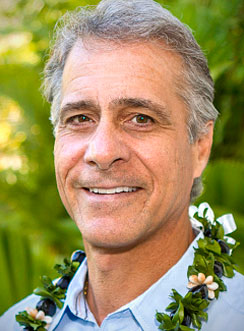The University of Hawaiʻi at Mānoa offered a Land Acknowledgement, a formal statement paying tribute to the original inhabitants of the land, during the opening session of the 2019 National Diversity in STEM Conference by the Society for Advancement of Chicano/Hispanics & Native Americans (SACNAS). UH is the presenting sponsor of the three-day conference held at the Hawaiʻi Convention Center.

UH Mānoa Provost Michael Bruno delivered the Land Acknowledgement as part of his opening remarks stating, “…it is with profound reflection that I offer up this Land Acknowledgement, acknowledging Hawaiʻi as an indigenous space whose original people are today identified as Native Hawaiians. The ʻāina on which we gather is located in the ahupuaʻa of Waikīkī, in the moku of Kona, on the mokupuni of Oʻahu, in the paeʻāina of Hawaiʻi. I recognize that her majesty Queen Liliʻuokalani yielded the Hawaiian Kingdom and these territories under duress and protest to the United States to avoid the bloodshed of her people. I further recognize that generations of indigenous Hawaiians and their knowledge systems shaped Hawaiʻi in a sustainable way that allows me to enjoy her gifts today. For this I am truly grateful.”
Bruno also spoke about how this is a moment of change in Hawaiʻi’s history and of the universityʻs struggle with its support of the Thirty Meter Telescope on Maunakea and its commitment to becoming a Native Hawaiian place of learning and a model indigenous-serving institution.
Provost Bruno’s full message
Aloha kākou,
Wow, as I look out and around this room, I am inspired, humbled, and full of hope for the future. And I am honored to welcome you, on behalf of the University of Hawaiʻi, to the 2019 National Diversity in STEM Conference!
On behalf of the University of Hawaiʻi, it is with profound reflection that I offer up this Land Acknowledgement, acknowledging Hawaiʻi as an indigenous space whose original people are today identified as Native Hawaiians. The ʻāina on which we gather is located in the ahupuaʻa of Waikīkī, in the moku of Kona, on the mokupuni of Oʻahu, in the paeʻāina of Hawaiʻi. I recognize that her majesty Queen Liliʻuokalani yielded the Hawaiian Kingdom and these territories under duress and protest to the United States to avoid the bloodshed of her people. I further recognize that generations of Indigenous Hawaiians and their knowledge systems shaped Hawaiʻi in a sustainable way that allows me to enjoy her gifts today. For this I am truly grateful.
Located in the most diverse community and environment in the world, the University of Hawaiʻi is one of the world’s leading research universities AND the most community-serving institution I have ever known. This duality of scholarly excellence and community service is in fact what drew me to the university and what keeps all of us going every day. The 10-campus University of Hawaiʻi System is one of the most ethnically diverse institutions in the nation; a land, sea, space, and sun-grant university that includes the only freestanding school of indigenous knowledge at a major research university (UH Mānoa), and the only college dedicated to an indigenous language at a public comprehensive university (UH Hilo).
By way of introduction, I am a first generation student and the son of immigrant parents who sacrificed everything so that my siblings and I could follow our dreams. My journey from the islands of New York to the islands of Hawaiʻi was made seamless by the aloha shared with me by the faculty, staff and students of this great university. I am humbled every day by the profound and lasting impact of the efforts of our faculty, students and staff here in Hawaiʻi and well beyond. Our world-class research portfolio and our commitment to excellence in teaching defines and guides our kuleana—our responsibilities and privileges—to Hawaiʻi, the Pacific, and the world.
It is important to consider the context in which we come together this morning. This context is embodied in the Hawaiian phrase HE HULIAU: A time of change; a turning point. We are all witnessing huliau. Climate change requires that we re-examine the ways in which we care for our lands, and in which we conduct our research and educate our students. We see rapid technological change all around us, as well as geopolitical shifts, rising income inequality, disparities in health care and education, and demands for social justice across our communities and institutions.
Here at home, our struggle over the construction of the Thirty Meter Telescope on Maunakea challenges us to reflect on the mission of the University. We are internationally recognized for our research strengths, including astronomy. At the same time, we have publicly committed to becoming a Native Hawaiian Place of Learning and a model indigenous-serving institution. How do we, then, reconcile the building of the telescope? As I consider this question, I cannot help but recognize the opportunity for our students to develop research and critical thinking skills, and to engage with our learning objectives of sustainability and civic engagement. It is my strong belief that by introducing our students to different knowledge systems, including those that can appear at times to be in conflict, we will build ethical leaders with the confidence and creativity to thrive even in times of change and disruption.
I look forward to spending the next few days with you, and I wish you well as we come together to listen and learn from each other, and chart a course to do great things. Together. Mahalo!
Michael Bruno
UH Mānoa Provost

